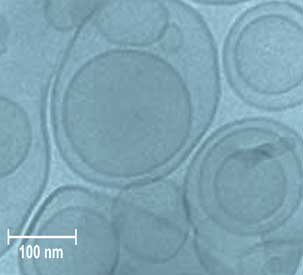The “Magic” of Liposomal Encapsulation Technology
 |
| Liposomes as viewed through an electron microscope. The nano-size and the phospholipid composition of these nutrient-filled liposomes allow them to passively slip into the bloodstream from the small intestines without impediment and without the need for any type of active transport or osmotic pressure. |
This is particularly important for anti-oxidant nutrients like Vitamin C that are easily oxidized by electron-hungry substances in the air we breathe.
Phospholipids are also impervious to digestive juices which make liposomes ideal for transporting acid- and enzyme-reactive substances through the digestive tract.
In addition, the submicroscopic size of nutrient-filled liposomes is so small that they easily pass through the intestinal barrier without requiring help from an active transport system or from osmotic pressure in the gut. Hence, virtually all of the nutrient is carried straight to the cells that need it.

